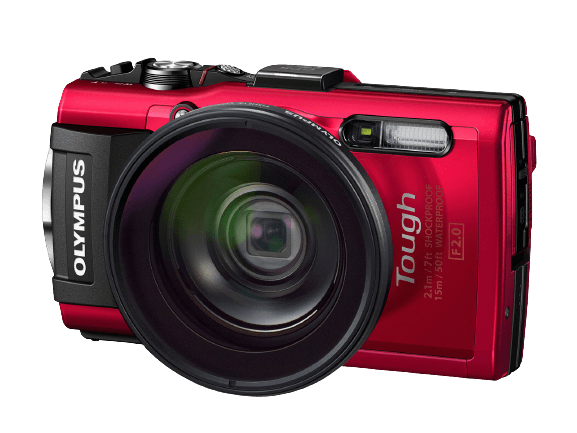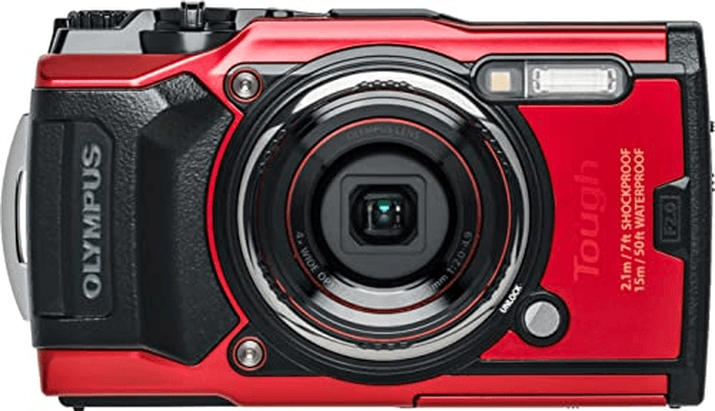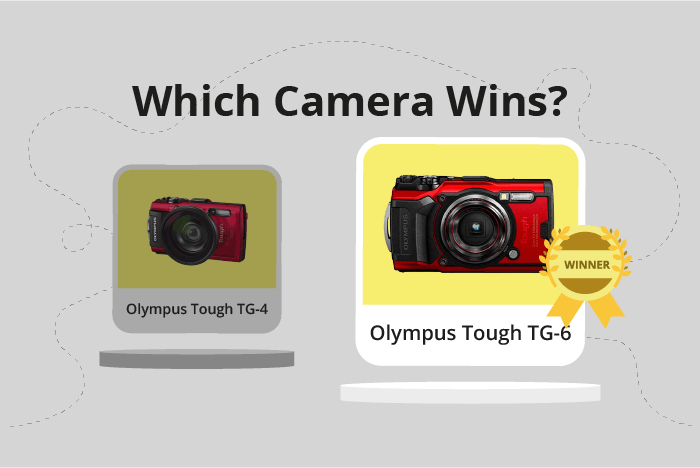Olympus Tough TG-4 vs Tough TG-6 Comparison
Olympus Tough TG-4

Olympus Tough TG-6

The Olympus Tough TG-6 emerges as the winner with a score of 59/100, outperforming the Olympus Tough TG-4, which scored 49/100. Both cameras share similarities, such as being compact in size and having a similar weight (TG-4 at 247g and TG-6 at 253g). Additionally, both cameras have the same dimensions, with only a slight difference in width and depth.
The TG-6’s higher score is attributed to its more recent release in 2019, compared to the TG-4’s 2015 release. This allows it to incorporate updated technology and features, justifying its higher launch price of $450, compared to the TG-4’s $379.
The TG-4, however, has a slight advantage in being lighter and slightly smaller, making it more portable. Despite these differences, the Olympus Tough TG-6 stands out as the better choice due to its improved technology and features, while the Olympus Tough TG-4 may still be a viable option for those prioritizing portability and a lower price.
Olympus Tough TG-4 vs Tough TG-6 Overview and Optics
The Olympus Tough TG-4 and Olympus Tough TG-6 have tied with optic scores of 52/100. Both cameras share several specifications, including sensor type (CMOS), sensor size (1/2.3″), fixed lens mount, and image stabilization. Despite these similarities, there are differences that make each camera stand out in its own way.
The Olympus Tough TG-6 has a few advantages over the TG-4. It has a faster shooting speed of 20, allowing users to capture more images in a shorter amount of time compared to the TG-4’s shooting speed of 5. Additionally, the TG-6 features a more advanced processor – the TruePic VIII – which contributes to improved image quality and processing speed.
On the other hand, the Olympus Tough TG-4 has a higher megapixel count of 16, compared to the TG-6’s 12 megapixels. This means the TG-4 can capture images with greater detail and resolution. Furthermore, the TG-4 has a slightly higher DXOMARK score for its sensor (74) than the TG-6 (70), indicating better image quality.
In terms of optics, both cameras have their strengths and weaknesses. The Olympus Tough TG-6 excels in shooting speed and processing power, making it suitable for users who prioritize capturing fast-moving subjects or high-speed action. Conversely, the Olympus Tough TG-4 offers higher resolution and slightly better image quality, which may appeal to those who prefer to capture detailed images. Ultimately, the choice between these two cameras will depend on the specific needs and preferences of the user.
Olympus Tough TG-4 vs Tough TG-6 Video Performance
The Olympus Tough TG-6 outperforms the Olympus Tough TG-4 in video capabilities, scoring 83 out of 100 compared to the TG-4’s score of 57. Both cameras share some common specifications, such as having time-lapse functionality built in. However, the differences in video quality and performance make the TG-6 the superior choice for capturing video.
The TG-6 boasts a higher maximum video resolution of 4K, with dimensions of 3840 x 2160 pixels, while the TG-4 only offers Full HD with dimensions of 1920 x 1080 pixels. This results in the TG-6 capturing sharper and more detailed videos. Additionally, the TG-6 has a maximum video frame rate of 60fps, double the TG-4’s 30fps. This allows the TG-6 to record smoother motion and better slow-motion videos.
The TG-4, on the other hand, does not have any significant advantages in video capabilities over the TG-6. The only similarity between the two cameras is the built-in time-lapse functionality, which is not enough to make the TG-4 a better choice for video recording.
In comparing the Olympus Tough TG-4 and TG-6, it is evident that the TG-6 is the better camera for video recording. The higher video resolution and frame rate provide superior quality and performance, making it the clear winner in this comparison. The TG-4, with its lower video score and limited capabilities, cannot compete with the TG-6 in this aspect.
Olympus Tough TG-4 vs Tough TG-6 Features and Benefits
The Olympus Tough TG-6 is the superior camera with a feature score of 83/100, while the Olympus Tough TG-4 has a score of 49/100. Both cameras share some common specifications, such as a 3-inch screen size, GPS, and WiFi capabilities.
The TG-6 outperforms the TG-4 in several aspects. Its screen resolution is significantly higher at 1,040,000 dots, compared to the TG-4’s 460,000 dots. This higher resolution provides clearer and sharper image previews. Additionally, the TG-6 has a touchscreen, making it more user-friendly and efficient in navigating menus and settings. The TG-6 also includes Bluetooth connectivity, which allows for seamless sharing and remote control of the camera.
In contrast, the Olympus Tough TG-4 lacks some of these advanced features. It does not have a touchscreen, and its screen resolution is lower. It also does not have Bluetooth connectivity. However, the TG-4 still offers a decent set of features, such as GPS and WiFi, which are useful for geotagging and sharing images.
Considering these points, the Olympus Tough TG-6 is the clear winner in terms of features. Its higher screen resolution, touchscreen capabilities, and Bluetooth connectivity make it a more advanced and versatile camera. The Olympus Tough TG-4, while not as feature-rich, still offers valuable functionalities for photography enthusiasts. Ultimately, the choice between these two cameras will depend on the user’s preferences and priorities, but the TG-6 is undeniably the better camera in terms of features.
Olympus Tough TG-4 vs Tough TG-6 Storage and Battery
The Olympus Tough TG-6 outperforms the Olympus Tough TG-4 in storage and battery with a score of 35/100 compared to 21/100. Both cameras have one memory card slot and accept SD, SDHC, and SDXC cards. However, the TG-6 is compatible with UHS-I cards, offering faster performance.
The TG-4 has a slight advantage in battery life, providing 380 shots compared to the TG-6’s 340 shots. Both cameras use the same LI-92B battery type. The TG-6 compensates for its shorter battery life by offering USB charging, a feature absent in the TG-4.
While the TG-4 has a longer battery life, the TG-6’s compatibility with UHS-I cards and USB charging capability make it the superior choice for storage and battery performance.
Olympus Tough TG-4 vs Tough TG-6 – Our Verdict
Are you still undecided about which camera is right for you? Have a look at these popular comparisons that feature the Olympus Tough TG-4 or the Olympus Tough TG-6:

